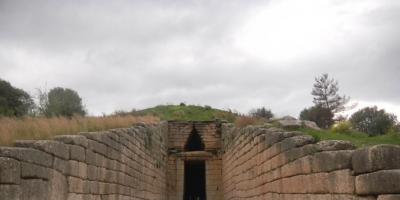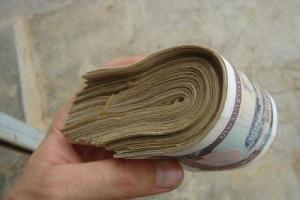An indoor fountain will decorate the house, humidify the air in the room, and give a little coolness on a hot day. There is no need to buy expensive installations. If you consider yourself a creative person, then be patient, give free rein to your imagination and start creating a fountain with my own hands.
The design of an indoor mini fountain is quite simple. It is based on the principle of a closed cycle: water is poured into a system connected to a power source, while a submersible electric pump lifts the water upward, and then, depending on the type of structure, it flows into a storage tank.
An indoor fountain can be of three types depending on the method of water discharge:
- gushing: the stream shoots up and falls into the mini-pool;
- cascading: water falls from a small height, flowing over decorative ledges;
- closed: water circulates in flasks or flat wall-mounted containers in the form of pictures.

Photo source: http://svoimirykami.ucoz.ru
Indoor fountain location
Before starting work, decide on the size and location of the future fountain. A bulky, large fountain will look out of place in a small apartment.
An indoor fountain can be floor, wall or tabletop. The choice depends on the size of the room and the functions assigned to the fountain. For small room A small tabletop fountain would be optimal.
Functionally, the fountain serves not only as a decorative item, it humidifies the air well. Therefore, fountains should not be installed near wooden furniture: It can deteriorate from constant moisture. When choosing the location of the fountain, also take into account the presence of small children or pets in the house: install the structure where it will not disturb anyone.

Photo source: http://www.coonplace.ru/
Materials for creating a fountain
Most often, indoor fountains are made of glass and stone. The glass part is a kind of foundation for the fountain, its basis. Stones are used to stabilize the structure. For fountain parts that do not come into contact with water, you can use wood, ceramics, and synthetic materials.

Photo source: http://www.zoloto72.ru
An indoor fountain can be supplemented with lighting. At night, such a fountain will serve as a kind of night light. A sound background and an additional built-in clock or barometer will make the fountain functional.
The main element for creating an indoor fountain is a pump ( water pump) for water circulation. An indoor fountain is a small installation, so don't go overboard. Choose low-power, silent pumps for aquariums or specifically for small fountains with a capacity of approximately 6 W and 240 l per hour. The higher the power, the noisier the pump. You should hear the murmur of water, not the operation of an electric motor.

Photo source: http://svet-lanka.blogspot.ru
Indoor fountain decor
The beauty of creating a fountain with your own hands lies not only in saving money, but also in the opportunity to decorate it to your own taste. If you have difficulties with inspiration, you can always take advice from people who know: look through magazines about interior design.
What might be suitable as decor? Before you run to the store, think about how many cute little things you have lying around your house, unused. A pot, ceramic pot or vase, shells and pebbles brought from the sea - the most popular “filling” for fountains – can be used as a base. Even souvenir figurines can find a second life. Artificial trees and flowers, gravel, living plants - all this can become decor for a fountain.
To create flowing water, you can use different containers: bowls, sea shells, lakes, etc.

Photo source: http://domgvozdem.ru/
Indoor fountain step by step
Making a fountain with your own hands is very simple. The main things you will need:
- sealed container for a fountain: flower pot, vase, pot, bucket;
- water pump (pump for moving water). The pump can be purchased at hardware store or at a pet store, a low-power water pump for aquariums will do;
- a piece of hose (for example, for cleaning aquariums);
- decorative elements.

Photo source: http://www.trozo.ru
We install the pump at the bottom of the selected vessel (the pump has suction cups) and attach a hose to it. We cover the pump with stones, and the water supply tube is brought up between them. We cover the space around the pump with large decorative elements (expanded clay, stone), then with smaller ones (pebbles, shells, glass). We leave only the outlet of the filter, and fill the rest with water. The tube, like the pump itself, should be completely masked so as not to disturb the harmony of the composition. And then the decor and design at your discretion.

Photo source: http://home-sweet.ru
A good solution is to “seat” a figurine (frogs are often used) on a tube supplying water. To do this, you need to drill a hole in the figurine and thread a tube into it, water will flow from the frog’s mouth.
Reliable fixation and sealing of the entire structure is achieved through the use of waterproof adhesives.
The power of water emission is controlled by a wheel located on the pump body. This power also depends on the diameter of the tube: the smaller it is, the higher the jet, accordingly. If you want water to flow out in several streams, install a divider on the tube.
Operating an indoor fountain does not require much effort and consists only of maintaining a sufficient water level for circulation. There should be enough water so that the pump is constantly in the water. The water will evaporate, so it will have to be added to the fountain every week.

Photo source: http://tvoidizain.ru/
Funny video
The 2 year old loves to throw. Look what happened when his parents bought him a basketball hoop!
It seems that the days have passed when Russians’ summer cottages and private courtyards were exclusively an area with laid out beds and planted trees and shrubs. Modern garden plot, large private yard or a tiny backyard within an urban home can become a work of landscape art. Beautiful flower beds, neat garden paths, barbecue areas, swings and gazebos – there are plenty of options for arranging even modest-sized yards. But as the Japanese say, they are great specialists in creating the perfect landscape design– for a harmonious environment in your yard or summer cottage there must be three components: plants, stones and water. It is the introduction of a source of water into the arrangement local area will be the subject of this publication. let's consider possible options creating a fountain on a summer cottage or personal plot, within a small courtyard or a huge local area.

Types of fountains for landscape design of a site
The generally accepted opinion that a fountain in a summer cottage is expensive, labor-intensive and generally troublesome has long been unfounded. Organize a source with constantly circulating water on our own It’s not difficult if you approach the issue with care and accuracy. Well, there are so many ready-made options in modern stores that it’s easy to get confused.




Choosing a fountain, like any device for decorating a local area, requires precise calculations and the correct selection of shapes, sizes and materials. Before you go to the store or on the Internet in search of videos with master classes on making a fountain with your own hands, you need to decide what types of fountains are and how they differ from each other.



This type of fountain can be considered the simplest in terms of design and installation. The peculiarity of the submersible mechanism is that the jet shoots directly from the water. But this option requires the presence or creation of a small reservoir - an artificial pond or a large bowl of water that is immersed in the soil. The submersible version of the fountain is one of the least expensive. It is enough to select a suitable spray nozzle that forms a jet and fix the hose from the pump. There is no need to install additional technical devices.


These are the designs we imagine most often when we talk about fountains in parks and squares. This type of fountain requires the presence of some decorative elements that imitate a water source. A stationary fountain for a summer house or private courtyard can use jets, sculptures or their compositions, and various elements of landscape decor.




The design of a stationary fountain itself is somewhat more complicated than a submersible type mechanism, but it also looks like this decorative element landscape design is more respectable and effective. This is especially true in cases where it was possible to find a fountain model that fits the overall design concept of the site (or make it yourself).



Among the many models of stationary fountains, products made of polymer material, which perfectly imitates natural stone. Products made from polystone look like models made from natural stone, but at the same time they are significantly cheaper, lightweight and easy to install and operate.



Fountains made of polystone can be either one object or a composition of several elements - there are countless options. In any case, the material is not subject to rotting or deformation, and is able to withstand jets of water even under fairly high pressure.



Fountains in which water flows over the main element or a whole composition of objects look stylish, modern and creative. It seems that the stone itself is a source of moisture. Meanwhile, water flows through a hose, which is located in the center of the hole of the boulder (or any other decorative element).



Fountain-waterfall “falling water”
Not fewer varieties fountains that imitate both jets and water falling from something like a waterfall. In such a combined composition, the fountain jets, rising upward, do not easily fall back into the water, but end up on a cascade of stones or stepped decorative elements.






Making a fountain with your own hands
So, you have decided on the type of fountain and are ready to get to work. But wait until you dig the pit. It’s not for nothing that popular wisdom says: “measure seven times, cut once.” It is necessary to carefully plan your actions, make the necessary calculations, and carry out a series of preparatory work.




Choosing a place for a fountain
A successful choice of area for the location of the fountain is an important item on the to-do list for arranging the local area. After all, we don’t want to not only decorate the site, but also create an atmosphere of peace and comfort, in which the sound of running water will allow you to relax and forget about the hustle and bustle of everyday work. On the one hand, I want the fountain to be in a zone of constant visibility, so that it can be admired from anywhere on the site (but most often this desire is unattainable, because there are buildings, trees and tall bushes on the territory), on the other hand, to be located near the recreation area .




If you are planning to manufacture a submersible fountain, then you need to consider the following nuances:
- The fountain should not be placed directly under a tree or tall bush - falling leaves will not only clog the water, but can also cause the pump to break down. In turn, the root system of a tree can cause destruction of the entire structure;
- a fountain in even a small body of water will cause high humidity and possible damage to the facade if it is located in close proximity to a house or other buildings;
- It is also important to take into account the wind rose in your area, at least the predominant wind direction. If you place a reservoir with a fountain on the leeward side, then most time will have to be spent cleaning up garbage, and not enjoying the beauty of the structure and the sounds of flowing water;
- but also absolutely open area yard - not the best option for the location of the fountain (especially for regions of our country where summers can be very hot). During the day, light and shadow should replace each other. Otherwise, the water in the tank may become very hot, which will damage the pump. And the water will begin to turn green faster in constantly hot water.



Choosing a bowl for an artificial pond
In this matter, the determining criteria will be the type of fountain and the size of the reservoir being manufactured. In order to optimize the costs and time of making a fountain with your own hands, the easiest way is to choose ready bowl from a composite from the available range of stores. A wide range of shapes, sizes and colors will allow you to do this without much effort.


Experts recommend choosing bowls made of composite materials because they do not undergo thermal deformation. If your pond has small sizes, and it’s not important for you to make any choice original form, then it’s better to buy ready-made option. Otherwise, you will have to make the bowl yourself - this is a labor-intensive process that takes a lot of time. But as a result, you will get the ideal vessel for your country pond. This topic is extensive and worthy of a separate publication. But not all elements for the garden fountain have been selected yet.




Choosing a pump for a DIY fountain
A pump for a fountain must not only push a stream of water to the desired height, as is required in a country waterfall or an artificial stream, but also push the water out from the right pressure to a certain height above the surface. Of course, there are formulas for searching required power pump for a given jet height and optimal hose diameter, but for those who do not want to delve into the details of the calculations, we offer the following list of correspondences:
- for a jet height of 50 cm, the hose diameter is 1.5 cm, and the pump capacity is 1000 l/h;
- for height 100 cm, diameter – 1.5 cm, pump 2000 l/h;
- jet 150 cm, diameter – 2.5 cm, productivity 3000 l/h;
- pressure height 200 cm, hose diameter 2.5 cm, power 5000 l/h;
- for a jet with a height of 300 cm or more, you will need a hose with a diameter of 2.5 cm or more, and a pump with a capacity of 8000 l/h or more (but such designs are used extremely rarely for country landscapes).


There are many varieties of attachments for creating original types jets, they all leave their mark on the choice technical characteristics equipment. In any case, all parameters of the pump will be indicated in its marking, on the box and in the technical data sheet of the product. If you want to make a “geyser” type fountain or use original attachments (such as “bell, etc.), then contact the consultants in the store for help.


Decorating a country or garden fountain
Of course, the main criteria for choosing decor for a fountain will be only your imagination and financial capabilities. Although, for many types of decor the costs will be symbolic. For example, if you choose a polystone fountain model, then decor is not needed at all. Such models are most often presented in a fairly laconic design and do not require decorations.



If you want to create the most natural atmosphere, close to the environment of wild nature, throughout the entire area in general and near the fountain in particular, then it would be a good idea to adhere to the following simple recommendations:
- to decorate the fountain, use stones of one or maximum two types, because in nature it is rare to find a pile of stones that differ significantly in their aesthetic qualities;
- plants that will be in close proximity to a fountain or located in a pond are best chosen from the class of those for which water or very high humidity is their natural habitat;
- if in yours artificial reservoir will be inhabited by fish, then you need to find out in advance whether a particular decorative species is able to calmly endure the noise of falling water.




In custody
The listed fountain options and the photos proposed for them are only part of the ways to create an original source of water for summer cottage, a private yard or just a local area. There is no limit to the imagination for creating combined models and using non-standard materials. Whatever your choice, it is important that any fountain will give your site a special flavor, make the landscape design complete, more harmonious, increase humidity and create a peaceful, relaxing atmosphere in the recreation area (or near it).




IN Lately Particularly popular are the so-called “vertical fountains”, which are literally a “water wall”. They look stylish, modern and easily fit into almost any landscape design style without taking up much space.







Now many people have a desire to have (especially in summer) a small fountain that would make the atmosphere more exotic. But many are sure that this idea is beyond their means. You can try to make this dream come true at home. A homemade one can be made in a few hours, even if you have never created such things.
Such products are divided into indoor (decorative) and yard, arranged in summer cottages or courtyards multi-storey buildings(if they do not interfere with garages, etc.). There are many different designs for home fountains. Let's consider how it is possible to make at least a small one with your own hands indoor fountain. To begin with, let’s think through the future design according to the following parameters:
- Desired sizes.
- Form.
- The number of cascades of your fountain.
- Correct design of the closed water system of the product, otherwise the fountain will not work normally.
Now you have passed the first stage, and you have a drawing of your fountain on paper. Now comes the next stage: you need to prepare materials and parts for assembling your idea. Here is a rough list:

- Small. If you are planning to do desktop version, then you can use an aquarium pump.
- Hermetically sealed container made of metal or plastic. For these purposes, you can adapt any utensils available in the house (vase, plastic bucket, basin).
- For decorative design you can use pellets, shells, decorative colored glass, etc.
- Electrical cords, sockets for connecting the pump.
Making your own fountain at home
Assembly begins by installing the pump on the lower part (bottom) of the container you choose. To do this, you can use synthetic adhesives or suction cups (if you are using an aquarium pump, they are included in the kit). The water is raised to the upper level using a tube (plastic, silicone). We put it on the outlet of the pump and secure it strictly vertically. Next, to disguise the pump and isolate it from the external environment, it is necessary to cover the equipment with a homemade or purchased frame of suitable size. If you are planning to make it yourself, then do not forget to prepare the necessary materials and tools for this.
If you have a plastic box with dimensions suitable for the pump, then cut out ventilation holes, use it as a casing. On extreme case You can put the pump under a layer of colored pebbles. Next, you need to turn on your imagination, since the final result depends on it. We take any container we like (a beautiful mug, a large sink, a plate, etc.)
It should be installed at some elevation.

This can be achieved by creating a slide of stones with your own hands, on which we mount our decorative tank with epoxy glue, into which a tube from the outlet end of the pump is inserted.
If there are no stones, then you can make cubes from polystyrene foam or use ready-made plastic ones. To do this, we drill a hole in the vessel we have chosen along the diameter of the tube that goes into the tank (into its internal cavity), 6-12 mm. We do it ourselves by sealing the hole and fixing all the elements using waterproof glue and sealants.
For those who want to update the exterior, make it special and memorable, we suggest using a small homemade fountain. Step-by-step instruction Making a fountain with your own hands is quite simple and anyone who has a certain set of tools and materials can create this beauty in their yard.
Installing a fountain at the dacha
The first point of the fountain installation plan is planning its size and type. Consider the size of the yard; do not make the fountain too large or small - this will not give a positive visual effect. Remember, the power of pumping equipment is directly proportional to the size of the structure.
Now you should select correct area land for installation. Firstly, the fountain should be located where it can be clearly seen. Secondly, it should be close to the vacation spot. The sound of running water and cool freshness in summer heat- important components of a pleasant and peaceful holiday in the fresh air. Try not to install the fountain in direct sunlight. The water will have to be changed frequently due to blooms. There is also no place for structures near trees; the roots can damage the thicket and for repairs you will have to dismantle the entire decorative element.
To install a fountain with your own hands on the site correctly, do not choose places near the walls. In this case, the structure will not avoid exposure to mold and mildew. And this, in turn, will not only spoil the appearance, but also cause an unpleasant musty smell.
Plan future buildings on the site in advance. You should not install a fountain on the road to them.
Step-by-step guide for installing a fountain in your country house with your own hands
Let's talk about how to make a fountain with your own hands using the example of a very simple design - fountain-fontanelle. A structure of this type has a number of advantages:
- Spectacular appearance;
- Easy care;
- Easy access to parts for repair purposes;
- Possibility of dismantling for winter.
Having selected a place for installation, we dig foundation pit slightly larger than a fountain bowl. Additionally, a shallow hole should be dug around it. gutter(about 10 cm).
DIY fountain. Instructions in photo
At the bottom of the pit there should be sand cushion 15 cm thick. This will protect the underground part of the structure from plant roots. Level the surface and install it on it plastic bowl. We level the font, pour in and compact sand. The container should be installed in such a way that its edges protrude by 5-8 cm.
The next step is to fill the plastic container under the bowl with water. There is no need to pour “heaping”; leave 4-6 cm to the edge.

Now it is necessary install a fountain and check the operation of pumping equipment. If power pumps can be adjusted, then we adjust it so that the water falls back into the bowl. The choice of equipment should be approached very carefully. Ideally, when purchasing, explain to the seller what bowl size and bowl volume is expected. Then he will help you choose equipment of the required power.

DIY fountain. Instructions in photo
After installing the bowl and pump, you need to do waterproofing fabric. We cut out a canvas with a diameter the size of a fountain pit. Starting from its center, cut strips. This must be done so that the diameter of the resulting inner circle is equal to the diameter of the structure’s bowl. We bend the resulting strips of material and lower them into the container. They can be secured using sealant. Do-it-yourself fountains always require a lot of patience and accuracy in work, especially this stage construction.

To ensure that the base of the structure does not lose its shape and is stable, we place a couple of rods on a sealed fabric fittings, and on top of them - galvanized fine mesh. The mesh size will influence the size of stones or crushed stones used used in the decor of the fountain.

DIY fountain. Instructions in photo
The final stage of construction - decoration designs. The border of the fountain can be laid out with larger stones, but you should not make it too clear. Small stones such as sea pebbles or crushed stone are laid out on the mesh. If it is necessary to add naturalness to the fountain, then its boundaries should not be too clear. Various plants will look good along the edges of the structure.  Thematic japanese fountainfor lovers of oriental exoticism it is installed in a similar way. Step-by-step instructions for making a fountain with your own hands for the garden in Japanese style consists of the same points. You will find a diagram of the structure below.
Thematic japanese fountainfor lovers of oriental exoticism it is installed in a similar way. Step-by-step instructions for making a fountain with your own hands for the garden in Japanese style consists of the same points. You will find a diagram of the structure below.

DIY waterfall fountain
We will not build anything grandiose, but small, about 1 m high, cascading waterfall We are quite capable. It has already been described in detail above how to prepare a pit for a pond bowl. But this time we are building a waterfall. And if there is no natural elevation for him, he will have to create it himself.
Do embankment convenient in the process of digging a pit. We simply throw the earth where the slide should be and carefully compact it. For the hose supplying water to the point where the water falls, make a small groove There are holes and embankments in the wall.

DIY waterfall fountain. Instructions in photo
After the foundation pit and embankment for the waterfall are ready, we begin to cover the bottom and walls of the mini-pond waterproofing material (for example, PVC film). The fabric must be laid in such a way that it not only completely covers the bottom and walls of the pit, but also protrudes about half a meter on the sides of the pit.

Be sure to lay a pipe for supplying water to the top of the waterfall in a previously prepared channel-ditch. Bend one edge 30-40 cm up.

This time we are making a permanent structure, and therefore it is best concrete a bowl of a pond. To begin, carefully lay out metal mesh at the bottom of the pit. The waterproofing must not be allowed to become damaged. Next, pour a layer of concrete about 12-15 cm thick.

How to make a fountain at your dacha with your own hands. Photo
Now you need to prepare bowl walls. We lay out the mesh, strengthening it in the solution that has not yet hardened. You can continue installing a fountain with a pump with your own hands, which will look like a cascading waterfall, within a day. We fill the walls of the pond bowl and finish the most difficult stage of construction.
The next part of the construction is decoration the resulting structure. We build steps on a pre-compacted slide. The step should be about 30 cm and three ledges will be enough.

On the resulting flat surfaces we post it flat sandstone, pebbles or any other material to your taste. We decorate the rest of the fountain, including the film around the perimeter, with stones, crushed stone, marble or other pre-prepared materials.

All that remains is to turn on the pump and fill the font of the structure with water. We watch the stream flow steadily down the steps of the waterfall and enjoy the originality of our suburban area. 
DIY stone fountain
How to build stone fountain? We'll talk about this right now. First you need to make sure you have all the necessary devices and materials. We will need:
- Water pump (underwater with medium power is suitable);
- Plastic container for the bowl;
- A metal or PVC tube for carrying an electrical cable;
- coupling;
- Flat stones and gravel;
- Wooden bars;
- Water flow power regulator;
- Copper tube with a diameter of 15 mm.

Pit for the fountain bowl there should be a slightly larger container prepared for these purposes. By filling the space between it and the walls of the pit with soil, we will significantly strengthen the position of the bowl. As in previous cases, do not forget to create a pit at the bottom sand cushion. On top you need to lay a layer of pebbles.

Water pump fits freely in the water tank. This will make it easier to repair it if the need arises. You can protect your water tank from debris by simply fine mesh. To give strength to the structure, they are placed on top of the metal mesh. wooden blocks (if desired, they can be replaced with metal fittings).





The base of the fountain will be metal pipe, which is attached vertically to the pump.
The next stage is preparation flat stones. To do this, using special tools, we make holes with a diameter slightly larger than the diameter metal pipe- foundations of the structure.


Next, using the principle of a children’s pyramid, we “place” the stones on the pipe. All that remains is to add decorative elements to the fountain and connect the pump. A very simple, but effective and beautiful fountain at the dacha with your own hands is ready for use.


A variety of do-it-yourself fountains in personal plots
Submersible fountains
If there is already a pond in the yard, then it can be used as a basis submersible fountain. The principle of its operation is simple. Water is supplied via a pump directly from the pond. In this case, to install a submersible fountain you will need:
- Pump;
- Water supply pipe;
- An appropriate nozzle for forming a water jet and giving it the correct direction.
The attachments come in a variety of different types. Eg, bell attachment is a two-disk design. The flow of water passes between them and changes when the gap is adjusted. Nozzle " geyser"—a tube narrowed toward the top—quite effectively copies the corresponding natural phenomenon.

Such structures have quite a lot of possibilities. For example, you can create the effect of a key gushing out of the ground. To do this, install the fountain yourself so that the end of the pipe does not protrude above the surface of the reservoir.
Using more complex attachments, you can significantly expand your decor options. The effect of spraying water, the simultaneous combination of several nozzles and many other variations for the choice of those who construct a fountain in their dacha.
Stationary fountains
A fountain of this type is a real find for amateurs and professionals of design art. Structures can take the form of natural stone fonts, antique structures; they are made from clay pots, plastic bottles and any material that is at hand. Fountains for Japanese gardens have become especially popular lately.
Any frost-resistant material will do: marble, fake diamond, sea pebbles and more. To decorate such fountains, they often resort to painting. There are two ways to do it:
- Coloring the material before manufacturing the structure;
- Painting the finished figure.

The first option costs much more, but it is also much more reliable. To protect against moss, fungus and mold, it is useful to treat the fountain structure with special products.
Small stationary fountain It will look good in family recreation areas or near children's playgrounds. Our master class “Do-it-yourself fountain in the country” will help novice designers correctly build, perhaps, one of the main decorative elements in the garden. suburban area. And it doesn’t matter whether it’s a small geyser fountain or a large cascading waterfall 2 meters high. The main thing is that it pleases the owners and does not cause problems.
Video instructions for making a fountain at the dacha
For any owner, the appearance of a summer cottage or yard is of great importance. Its design can be done by specialists, but, if desired, you can do it yourself. A fountain will be a successful decoration for a yard or area. It can also be built according to your own design.
Types of fountains
There are fountains for dachas different types. They are divided into types: by device, by appearance, according to the features of work, etc. Depending on the method of construction, country fountains can be circulation and flow, they are also called “Roman”.
Did you know? The first fountains appeared in Ancient Greece and in Ancient Rome.
Circulating suggest the water cycle. Water fills a certain reservoir (bowl, vase, reservoir) and is supplied with the help of a pump to a device from which a stream of water directly shoots out.

Everything is arranged in such a way that the outgoing water enters the reservoir and is pumped upward again. Thus, the device does not require water supply from a water supply system or a well. The only thing that is necessary is to add water to a certain mark, since it tends to evaporate or splash.
Flow fountains are arranged using water supply (well) and sewerage. Water flows upward, falls down and goes into the sewer. The method is, of course, irrational, but Such fountains have a number of advantages:
- aesthetic appearance;
- drinking water;
- the possibility of using water for watering lawns, flower beds, shrubs and trees.

Did you know? Tallest fountain in the world- 312 m. It's called a fountain« Fahda» , is located in Saudi Arabia.
Choosing a suitable location
If you decide to build a fountain on the site with your own hands, then, first of all, choose a suitable place for this. If there is a pond or a pond in the country, the choice of location is obvious. Where the pond is located, there will be a fountain. The structure of the pond, of course, will have to be modified and adjusted, but the foundation will remain.
If you are starting from scratch, then you need to choose a place, carefully weighing all the pros and cons. DIY garden fountains perform different functions: they humidify the air in the garden, which is good for trees, create cool conditions, can be used for irrigation, etc.

For this reason, you need to choose a place so that the fountain not only brings aesthetic pleasure, but is also useful. A suitable place for arrangement would be an open area between trees, bushes or hedges.
Trees and bushes should not overhang a pond or reservoir to prevent debris from falling into the water and leaves falling. This is harmful to water filters. Also, due to the proximity of trees, and therefore their root system, the underground part of the fountain may be disrupted or even destroyed. If your dacha has plants that cannot tolerate waterlogging, arrange the fountain away from them.
Important! Do not place the fountain near buildings.
There is no need to set up the structure in the open sun, as this can lead to water blooms. There is one more condition: a fountain in the country, made with your own hands, must be in harmony with overall design. Everything should be done in the same style. This should be an area that is clearly visible from the windows of the house and from any part of the yard, because you are building a fountain, first of all, for aesthetic pleasure.

Preparation of materials for construction
When a place for a fountain and its type have been chosen, a project has been developed, you need to determine what materials will be needed for construction. Let’s assume that the project is designed for a circulating jet static fountain with a single release of water, i.e., the “Geyser” type.
At home, to build a fountain with your own hands you will need cement, sand, crushed stone, durable polyethylene film and a construction façade mesh sized according to the diameter of the structure (both the film and the mesh must be the same size). In addition, you need a plastic container with a volume of about 50-70 liters, depending on the size of the structure.
If you plan to decorate everything with stones, then prepare them right away. It could be a wild stone the right size, cobblestones, granite, large pebbles, etc. To ensure proper operation, you will need a fountain pump.
Pump selection criteria
Depending on the type of fountain you need to choose a pump. For a “waterfall” we would choose a surface pump, and since we have a traditional fountain, we choose a submersible one.
Usually, submersible pumps perform their function perfectly. They are compact, quiet, easy to install and, importantly, affordable. There are submersible pumps different power. It is calculated in the amount of water pumped per 1 hour (l/h). 
The height of the jet will depend on the power of the pump. The maximum height is calculated based on the diameter of the “foot” you made. In this case, the pump does not need to be selected according to the principle “the more powerful, the better.” For the arrangement, we need one so that the jet is high enough and so that the spray does not fly beyond the “foot.” For a summer residence, the jet height is suitable from 80 cm to 1 m.
Important! It is necessary to ensure that water does not splash outside the fountain. Excessive humidity can lead to the death of plants and damage to things.
Manufacturers, as a rule, provide in the instructions a table of the relationship between power and jet height. Since we are equipping the Geyser, such a device will require a pump with a capacity of about 7000 l/h.
Installation principle of the pumping system
Pumping system installed 10 cm above the bottom on a stand (laid brick or mounting cabinet). A hose or pipe with water supply is connected to it. Usually the sprinkler comes complete with a pump, but if you don’t have one, you can make it yourself.
To do this, you can take a regular stainless steel pipe. The diameter will depend on the height of the jet and the diameter of the water spray. For a small fountain of 0.8-1.0 m, a diameter of 2-2.5 inches will be sufficient. The length will depend on how deep the pump is immersed. It is enough to leave 10-15 cm above the water. 
To give the stream a shape, you can flatten the pipe, roll it, leaving a hole, drill several holes, or cut a thread and screw on the desired nozzle. Connect to the pump directly or via an adapter (if necessary).
Installation of a fountain. Step-by-step instruction
Master class on installing a fountain in a country house with your own hands step by step photos easy to find on the Internet. Typically, installation takes place in several stages.








